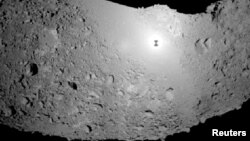What goes for Brazil nuts goes for asteroids, says a team of scientists.
Detailed photographs of the asteroid Itokawa, taken in 2005 by a Japanese spacecraft Hayabusa, revealed that its surface is covered with many large rocks, most probably ejected by its volcanoes.
But it looked like there were many more of those large boulders than the Itokawa’s craters could have spewed. A similar phenomenon was observed in 2001, on asteroid Eros.
After conducting many simulations, scientists at the University of Dundee, in Scotland, say it happened because of the so-called Brazil nut effect.
If you shake a bowl of nuts, including Brazil nuts that are larger than the others, the large ones tend to rise to the surface.
The effect has a complex dynamic, but it boils down to the fact that shaking creates spaces under larger nuts into which smaller ones fall.
Scientists say the Brazil nut effect most probably occurred after collisions of the Itokawa asteroid with other space rocks.




